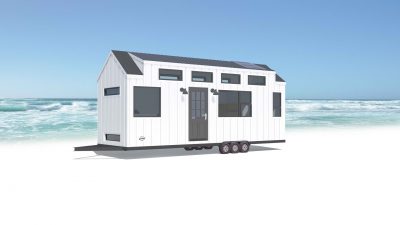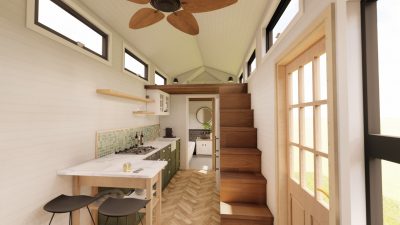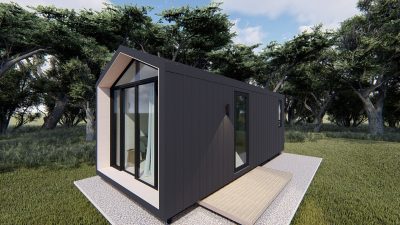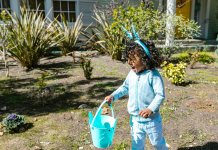With the growing trend towards smaller living, and not having the worry of a high mortgage over your head, most architects will vouch that container living is finally becoming a thing in South Africa. We chatted to Matt and Kendal Bower, who moved into a tiny home to show that living small really can be for everyone.
Leading an active working life, with Matt working and owning an event infrastructure company and Kendal dabbling in a variety of industries from interior design to psychology and sales, the couple is not the type to shy away from any opportunity in business, nor from the chance to change lives, just as they changed theirs. Only, it did take a rather humorous head injury to get them to where they are.
‘To help you understand the hilarious circumstances of how our business was created, I need to first explain Matt,’ gushes Kendal. ‘Matt is brave and confident. He loves working and bettering himself; he has a brain like the character in the movie Rainman, which I think makes him the entrepreneur he is today. Needless to say, he can’t sit still. In early January 2019, Matt opened the car door so fast that he smashed it into his head causing him a concussion. Under strict instructions not to read, write or look at any form of screen, the man’s brain could just not switch off, so it was no surprise to find him the next day (7 January and my first day back at work) waiting at the door, arms crossed with this grin on his face. I knew my life was about to change.’

That night over dinner Matt convinced Kendal they needed to start a tiny home manufacturing business in South Africa. Pre-concussion they had watched the Netflix docuseries Tiny Home Nation, so Kendal knew the concept well. She says she was immediately on board as she fully trusts Matt’s savvy business brain and she knew something like this would be welcomed by South Africans.
‘He then suggested that as a young engaged couple (at that time), move into a Tiny Home and live the lifestyle. That was where the wheels fell off and the tears and profanities started to flow. Hands in the air, I told Matt I would not be trailer park trash. We were planning our dream wedding; how could my bridesmaids come and visit if we only had one loft bed for them to sleep in!’

Today she looks back and laughs at her reaction. Kendall has no qualms to hide her initial feelings towards tiny home living, as she knows these are the same thoughts and feelings expressed by many of their potential clients. ‘But back then it was only when Matt asked me how we could sell a product that we didn’t believe in, that it hit home. I realised that if any couple was going to get through this it would be us, and if it failed, then at least we had an epic experience that we could tell our kids about one day.’
Fast forward to June 2019 where the couple launched their tiny home at the East Coast Radio House and Garden Show, alongside their young, innovative, like-minded business partners Dayne Frost (architectural designer), Megan Jeannes (graphic designer), Ryan Grunder (advocate) and Angelo Nel (plumbing). Since launching Wanderlust Co – their social movement that encourages living simply -the interest in tiny home living has grown exponentially and even more so now since the pandemic has people re-evaluating their financial situations. Based in Tongaat, they now make a variety of houses that can sleep up to six people, with the aim of reducing living costs and the negative impact on the environment.

According to the couple, the appeal of tiny home living is first and foremost the quaintness, moveability and cost. Matt says normal housing is priced beyond what the average South African can afford these days. ‘Approximately R1 million is what the average house costs, while the average first-time bond applicant is only granted around R800,000. But with shipping containers, a starter home can come in under R100,000.’
Based on a trailer, these tiny homes are a maximum of 20m2 and consist of a bathroom, kitchenette and bedroom/living area. They are equipped with everything needed to enjoy normal living (just in a more compact space) – full size stove, fridge, TV, cabinetry and are finished with minimal to luxurious features.
‘It’s up to each individual when it comes to extra fittings and features such as security alarm, beams, security camera, home automation system, solar panels… even a composting toilet. The sky really is the limit,’ beams Matt.

The couples Pod Homes are the latest addition to their portfolio. Starting at R250,000 for a 20m2 home, not based on a trailer, they consist of the standard fittings being a bathroom, kitchenette and bedroom/living area.
‘What is also great about these homes is that you can add on to them. A lot of South Africans are pro tiny home living, but find the 20m2 homes just a bit too small for them. Two pods give the space to have a dedicated bedroom en-suite, and a dedicated kitchen/living room with the footprint increasing to 40m2. There is no limit to how many pods one could ‘Lego’ together to make up the desired home.’
The trailer-based tiny homes can be parked on any privately owned land, as they are not deemed as permanent structures, but the pod homes require that you go through the normal application processes one would with a brick and mortar home.
‘For those short of the land to settle on, we are developing a database of interconnected parcels of land across the country of tiny home communities in which our clientele can park their home or construct their pod. The landowners would charge a monthly rental for the land occupied, water and electricity, much like a standard rental agreement.’

Because container homes are affordable in a tough economy, very easy to maintain, and they don’t have a major impact on the environment, Matt and Kendal take pleasure in living in their own innovative and eco-friendly design, and thrive on inspiring locals to give it a try.
‘What makes container homes more appealing is the fact that they are very versatile. From residential properties to low-cost housing schemes, schools, shopping centres, restaurants and more, there’s a whole world of opportunity when it comes to buildings created out of old shipping containers.’
As recycling has become trendy in the 21st century, shipping containers are even more popular seeing as they’re recyclable items. Homeowners can ‘go green’ even further by installing solar panels, as well as insulation.
‘Other advantages of container living are the houses are less disruptive and faster to erect than brick and mortar housing; they provide good air circulation; they’re tough, weather-resistant and vandal-proof. Living tiny means lower electricity and water costs as well as lower property maintenance costs. People who live in tiny houses use amenities a little more resourcefully and mindfully. And finally, they come with the freedom to move around and travel. Living in a tiny house is like living in a caravan, only it is cooler, a little bigger, more stylish and more efficient. A house on wheels means when you get tired of your surroundings, provided you have access to the land, you can easily move to your next destination.’

Matt points out that a downside to container homes in our country is that most banks don’t finance them, so you would have to do so by either paying cash or taking out a personal loan.
For many of us, the image of Stuart Little’s home in the children’s movie comes to mind when thinking of a tiny home. But, like the one in the movie, there is more to these types of structures in real life then you may initially think. Who would have known that we would one day look forward to living in smaller homes? If you said this 20 years ago, nobody would have taken you seriously.
Simply put, the trend toward tiny houses has become a social movement. People are choosing to downsize the space they live in, simplify, and live with less. People are embracing the tiny life philosophy and the freedom that accompanies the tiny house lifestyle. While one might argue that people all around the globe have been living small for decades, however, this is a different kind of small. It’s innovative, luxurious and deliberate.
Details: wanderlustco.co.za






